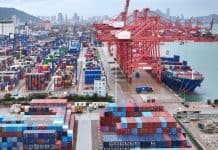
The rails movement of empty international and domestic sized containers into the Los Angeles market have spiked over the past month. The implication is that demand is outpacing the supply of available containers both on the west coast and overseas. The transportation market appears to be able to handle it.
The dominant flow of consumer goods into the U.S. is from Asia to southern California. These are items like electronics, furniture and apparel. The primary consumption markets are in the eastern half of the country, which means most of the goods that come in through the ports of Los Angeles and Long Beach get moved either by rail or truck to the east.
This trade route should not be confused with raw materials or routes associated with manufacturing and processing. Those are much more dispersed and less focused.
The route represents the American consumer with shipments of primarily finished goods. It has been formed over the past 30 years as companies recognized the cost effectiveness of producing their goods in Asia.
This mechanism is responsible for creating the largest imbalance in the flow of transportation capacity. The natural flow of goods continually puts pressure on Asian and Los Angeles market capacity.
The result is that container ships move back to Asia with empty — non revenue generating — containers. The same is true for truckload carriers and the railroads. Since there is no natural mechanism pushing capacity back to where it is needed most, capacity tightens rapidly at times.
Truckload tender volumes out of Los Angeles averaged over 20% higher in June, pushing tender rejection rates to multi-year highs over 8% before the Fourth of July. Tender volumes and rejections fell throughout July up until last week.
The data suggests intermodal had taken share from the truckload market and provided a way to relieve pressure on capacity.
Unlike June, last week’s spike in tender volumes out of Los Angeles did not have a strong impact on capacity as tender rejection rates did not increase meaningfully, moving from 5.1% to 5.45% in the past week. Spot rates from Los Angeles to Chicago were only up 0.4% week over week last Thursday.
The transportation market was able to absorb the blow leading into the Labor Day holiday weekend, but the surge of empties suggests that there may be more to come.
It does seem that efficiencies have been gained since the pandemic when port and rail infrastructure was overwhelmed. Truckload capacity remains in abundance, but that is the one aspect of the transportation equation that is changing.
Earlier this week, John Kingston wrote about the increasing instability in trucking sector credit, indicating that a wave of carrier exits is becoming increasingly likely.
September will probably not be the month that the domestic transportation market flips to a tighter state, but it is not without vulnerability. There are growing risks for the fourth quarter with strong demand side dynamics as capacity continues to bleed out.


























